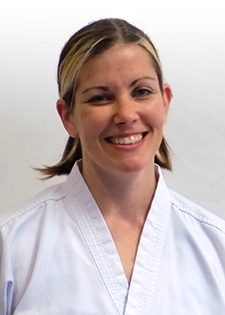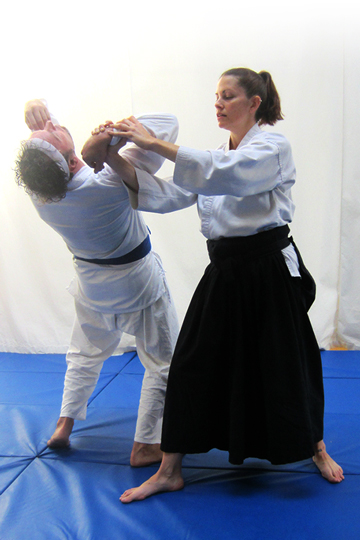 This Q&A with Joy Sensei is part of a series of interviews with the Aiki Arts Center yudansha (black belts).
This Q&A with Joy Sensei is part of a series of interviews with the Aiki Arts Center yudansha (black belts).
How did you get started with aikido?
In 2009-2010 I was in a yearlong Integral Coach certification program. The methodology emphasizes somatics, and one of our texts was Wendy Palmer’s book The Intuitive Body (the school now uses her more current book Leadership Embodiment). That put Aikido on my radar. The year of self-exploration made it clear that my developmental path was in the direction of grounding and embodiment—learning to keep my energy in my body and myself rooted to the planet. It occurred to me that martial arts would be a good way to do this, and since I knew about aikido from the course, I figured I’d start there. I found the Aiki Arts Center online, spoke to Azzia Sensei, and showed up at the dojo… and then just kept showing up.
Interesting story from that first night of practice actually. As I was driving home, sore, stunned, baffled, intrigued and awed, it began to hail harder than I’ve seen before or since. The sound was deafening as the ice balls piled on the ground centimeters at a time. As I neared my neighborhood in the Berkeley hills, the power blinked out around me. In my headlights I spotted two 11ish-year-old girls who had run out of their house and into the street in a panic. They were barefoot. They flagged me down, got in the car, asked to use my phone and, not being able to reach their parent who had gone out for the evening, came to my house where I gave them ill-fitting dry clothes and hot chocolate. Eventually we tracked down their equally freaked out mom who came to get them.
It wasn’t the most elegantly handled situation; however, remembering it now I see the symbolism of it. It was as though life was marking the beginning of the path I’d just stepped on, toward becoming a safe, calm space in the midst of intensity.
 What are you working on these days?
What are you working on these days?
These particular days—the pandemic days—I find I’ve returned to the ‘basics,’ which for me are getting and staying embodied. I’ve been more aware than ever of how fear, anxiety, and excessive empathy can pull me up and out of myself. I’ve been meditating every day with full awareness on my feet and center (hara). I am working on keeping my center low, flying under all the noise. Interesting that I came to aikido with that intention and that it’s now, nine years later, that I’m deploying what I’ve learned, consciously and in earnest.
What themes spiral through your practice?
I think it’s most common in our culture for folks to come to aikido hard, forceful, and needing to soften. My particular edges, at least in the physical aspects of my practice, have been around developing a more robust physical presence. I’m most challenged by things like ukemi, stepping in, triangles, boundaries, taking up space, and, of course, grounding.
Emotionally and mentally, however, my work has been something of the opposite: to stop trying so hard and allow the unfolding. Again and again I get lessons around how much more effective I am when I stop doing, stop forcing, and stop attaching to outcome. Of course this comes through in technique as well … the shapes I aspire to will come more easily when I stop trying so hard to make them. It’s one of the many beautiful ambiguities of this wonderful and mysterious practice.